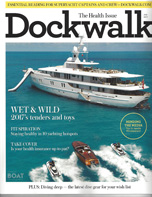 Excerpts from July issue of Dockwalk Magazine Featuring Maria Karlsson, President Superyacht Insurance Group.
Excerpts from July issue of Dockwalk Magazine Featuring Maria Karlsson, President Superyacht Insurance Group.Healthy, Wealthy, and Wise
What you need to know about health insurance.
Crew are getting smarter — at least when it comes to their health care. The Maritime Labour Convention (MLC) had a lot to do with that. “It has brought more awareness to crew that the owner has this financial responsibility with regards to their health,” says Maria Karlsson of Superyacht Insurance Group.
But just because the MLC says the boat must cover you, don’t think you don’t need to take responsibility for your own health. As health insurance is something you literally cannot afford to screw up, knowing a few basics about how the system works will go a long way towards long-term financial security.
P&I IS NOT HEALTH INSURANCE
If you get hurt on the job, the owner is responsible and their Protection & Indemnity Club will pay, but that’s not its main purpose. “P&I is there for big liability claims to protect the owner, not to provide ‘regular’ health insurance that covers doctor visits, physical exams, and other minor claims,” says Karlsson.
If a yacht has a group health insurance policy for its crew, that plan will always act primary to P&I, which means it will pay for all eligible claims. P&I should be your last resource, not your first P&I does cover work-related disability claims, though.
 Karlsson says she has seen an increase in crew asking for disability income and accidental death and dismemberment insurance (AD&D), particularly from Europeans who are used to the “Euro-styled ” crew medical plans usually underwritten by Lloyd ’s of London. These typically include this coverage, with a medical limit for AD&D that would be sufficient in Europe (but not enough for the U.S.). Karlsson points out that these benefits are also included in the yacht’s P&I. “I don’t think a lot of people are aware of that and get both; it’s double coverage that you pay for, yet you can only claim under one and in this case, the medical insurance, or personal accident (PA) insurance as it’s called in Europe, would act primary.”
Karlsson says she has seen an increase in crew asking for disability income and accidental death and dismemberment insurance (AD&D), particularly from Europeans who are used to the “Euro-styled ” crew medical plans usually underwritten by Lloyd ’s of London. These typically include this coverage, with a medical limit for AD&D that would be sufficient in Europe (but not enough for the U.S.). Karlsson points out that these benefits are also included in the yacht’s P&I. “I don’t think a lot of people are aware of that and get both; it’s double coverage that you pay for, yet you can only claim under one and in this case, the medical insurance, or personal accident (PA) insurance as it’s called in Europe, would act primary.”
YOU CAN HAVE A GROUP PLAN, AN INDIVIDUAL PLAN, OR BOTH
If you have a long-term job on a yacht with a good group medical plan, then terrific, you don’t need an individual policy. But let’s face it, yachts aren’t the most stable employers, and crew aren’t the most loyal employees.
Individual policies are portable from yacht to yacht, and they are essential if you are looking for a job, between jobs, or freelancing. “There’s a lot of crew turnover in the industry, and it’s difficult to switch policies each time the employment changes,” says Karlsson. In addition, while MLC-compliant vessels must offer medical and dental cover, some yachts rely on P&I insurance to satisfy MLC requirements and don’t have crew medical insurance. Other yachts may not provide a group plan and instead reimburse each crewmember for individual monthly policy premiums. “I have some big yachts that prefer to have individual plans,” says Karlsson. “I think the mentality there is the captain feels that the insurance responsibility is moved from him/her to the crewmembers themselves.”
 CONGRESS DOESN’T CARE ABOUT CREW
CONGRESS DOESN’T CARE ABOUT CREW
Actually, they have never even thought about yacht crew, which is why the provisions made for health care in the Affordable Care Act (ACA) are fairly useless for U.S. yacht crew.
The main issue with ACA-compliant health plans is geography. You have to purchase insurance in the state that you file taxes. “With many policies, you are pretty much out of network if you leave the town where you signed up,” says Karlsson, who adds that some policies are void if you are overseas for months at a time.
In addition, “U.S. domestic plans aren’t going to cover you if you get hurt while working,” she says, citing an example of a crewmember who ticked the box for “work-related incident” at the emergency room. Because of that, her insurance company rejected the claim for her knee injury, which ended up costing the owner about $5,000. U.S. insurance companies will consider anything work related to fall under worker’s compensation insurance, never mind that it doesn’t exist on yachts (though this is where P&I would kick in).
Despite these limitations, U.S. taxpaying crew are legally required to have an ACA-compliant policy (though this is expected to change with American Health Care Act legislation currently being debated).
“I shouldn’t advise people to be illegal, but you have to have a plan that’s going to work the best for you and your lifestyle,” says Karlsson. She prefers to sell international plans that are specifically designed for crew. They can be used worldwide and are much more affordable than the so-called Affordable Care Act plans. “International crew medical plans are going to cover you when you’re working and during your time off, in all states and overseas. It’s better coverage for less premium.” The tax penalty for not having an ACA- compliant plan runs the higher of 2.5 percent of your adjusted gross income or a flat fee, which for 2016 was $695. There are some people who never want to run afoul of the IRS and will buy ACA-complian coverage, he says, but Karlsson points out that there’s no ill effect on you as a citizen if you pay the penalty. There is one solution for American crew: GeoBlue offers ACA-compliant group coverage with excellent worldwide coverage. The only catch is it’s for groups, not individuals.
HEALTHCARE IN YOUR HOME COUNTRY IS NOT A GIVEN
Crew who come from countries with universal health care systems may think they don’t need insurance, but they need to make sure they are up to date with their social contributions, If you fall out of the system, it can take months to catch up and get back in. As for U.S. citizens, they can’t just buy insurance whenever they want. ACA policies are not medically underwritten, hence subject to approval, so everyone can get coverage and pre-existing conditions are covered from day 1. But “day 1” happens only one time a year. Policies must be bought during an open enrollment period (this year, November 1 – December 15, 2017, and take effect on January 1, 2018), unless there is a special circumstance, such as losing group coverage, getting married, or moving states.
MEDICAL COSTS IN THE U.S. ARE RIDICULOUSLY EXPENSIVE
The U.S. is one of the few industrialized countries that doesn’t provide free health care for its citizens. So those who have insurance pay higher costs to make up for those who do not, i.e. an average of $2,000 a day for a hospital stay, according to Kaiser State Health Facts; and that’s just for a bed, any care is extra. A short stay in a U.S. hospital can easily run into the tens and hundreds of thousands of dollars, which is why international policies that don’t include the U.S. or Canada are cheaper and a good idea for Med-based yachts.
